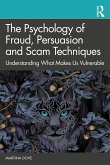The Social Science of QAnon
Herausgeber: Miller, Monica K
The Social Science of QAnon
Herausgeber: Miller, Monica K
- Broschiertes Buch
- Merkliste
- Auf die Merkliste
- Bewerten Bewerten
- Teilen
- Produkt teilen
- Produkterinnerung
- Produkterinnerung
The unique conspiracy group called QAnon is growing in both membership and political power, and understanding this phenomenon is key to combating QAnon's negative effects on society. This book uses social science theory to explain the attraction and spread of the defining conspiracy movement of our times.
Andere Kunden interessierten sich auch für
![Exclusion and Extremism Exclusion and Extremism]() Kipling D WilliamsExclusion and Extremism33,99 €
Kipling D WilliamsExclusion and Extremism33,99 €![The Cyber Predators The Cyber Predators]() Aaron Cohen (University of Haifa)The Cyber Predators37,99 €
Aaron Cohen (University of Haifa)The Cyber Predators37,99 €![The Ten Types of Human The Ten Types of Human]() Dexter DiasThe Ten Types of Human10,99 €
Dexter DiasThe Ten Types of Human10,99 €![The COMPASS Model in Criminal and Forensic Psychology The COMPASS Model in Criminal and Forensic Psychology]() Mark A. Durkin (UK Leeds Trinity University)The COMPASS Model in Criminal and Forensic Psychology65,99 €
Mark A. Durkin (UK Leeds Trinity University)The COMPASS Model in Criminal and Forensic Psychology65,99 €![The Psychology of Fraud, Persuasion and Scam Techniques The Psychology of Fraud, Persuasion and Scam Techniques]() Martina DoveThe Psychology of Fraud, Persuasion and Scam Techniques39,99 €
Martina DoveThe Psychology of Fraud, Persuasion and Scam Techniques39,99 €![American Conspiracism American Conspiracism]() American Conspiracism49,99 €
American Conspiracism49,99 €![The Journey from Prison to Community The Journey from Prison to Community]() The Journey from Prison to Community37,99 €
The Journey from Prison to Community37,99 €-
-
-
The unique conspiracy group called QAnon is growing in both membership and political power, and understanding this phenomenon is key to combating QAnon's negative effects on society. This book uses social science theory to explain the attraction and spread of the defining conspiracy movement of our times.
Produktdetails
- Produktdetails
- Verlag: Cambridge University Press
- Seitenzahl: 328
- Erscheinungstermin: 28. September 2023
- Englisch
- Abmessung: 228mm x 151mm x 17mm
- Gewicht: 490g
- ISBN-13: 9781009055024
- ISBN-10: 100905502X
- Artikelnr.: 67636796
- Herstellerkennzeichnung
- Libri GmbH
- Europaallee 1
- 36244 Bad Hersfeld
- gpsr@libri.de
- Verlag: Cambridge University Press
- Seitenzahl: 328
- Erscheinungstermin: 28. September 2023
- Englisch
- Abmessung: 228mm x 151mm x 17mm
- Gewicht: 490g
- ISBN-13: 9781009055024
- ISBN-10: 100905502X
- Artikelnr.: 67636796
- Herstellerkennzeichnung
- Libri GmbH
- Europaallee 1
- 36244 Bad Hersfeld
- gpsr@libri.de
Part I. Introduction to QAnon: 1. The 'who, what, and why' of QAnon Monica
K. Miller; Part II. Recruiting and Maintaining Followers: 2. Down the
conspiracy theory rabbit hole: how does one become a follower of QAnon?
Joseph Pierre; 3. Psychological motives of QAnon followers Ricky Green,
Carolina Trella, Mikey Biddlestone, Karen M. Douglas, and Robbie M. Sutton;
4. Cognitive processes, biases, and traits that fuel QAnon Arial R. Meyer
and Monica K. Miller; 5. The role of moral cognitions in the growth of
QAnon M. Katie Cunius and Monica K. Miller; 6. Emotions and the QAnon
conspiracy theory Elena Bessarabova and John A. Banas; 7. Recruitment to
QAnon: ordinary persuasion and human agency or 'brainwashing'? James T.
Richardson; Part III. QAnon and Society: 8. QAnon in the year 2020: the
bigger social picture Charles P. Edwards; 9. QAnon and the politics of 2020
Joseph Uscinski and Adam Enders; 10. The QAnon conspiracy narrative:
understanding the social construction of danger David G. Bromley and James
T. Richardson; 11. The need to belong: the appeal, benefits, and dangers of
QAnon and similar groups Kelly-Ann Allen, Zoe Morris, Margaret L. Kern,
Christopher Boyle, and Caomhan McGlinchey; Part IV. The Role of
Communication in Promoting and Limiting QAnon Support: 12. QAnon and social
media Tatyana Kaplan; 13. Social network analysis techniques using NodeXL
for analyzing disinformation related to QAnon Wasim Ahmed and Marc Smith;
14. QAnon, folklore and conspiratorial consensus: a case study in the
computational analysis of conspiracy theory narratives Timothy R.
Tangherlini, Vwani Roychowdhury, and Shadi Shahsavari; 15. Debunking and
preventing conspiracies: special challenges of QAnon John Banas and Elena
Bessarabova; Part V. The Future of QAnon: 16. Categorizing QAnon: is this a
new religious movement? Amarnath Amarasingam, Marc-Andre Argentino, Dakota
Johnston, and Sharday Mosurinjohn; 17. The future of QAnon: emergent
patterns of social movement adaptation and change Jared M. Wright and
Stuart A. Wright.
K. Miller; Part II. Recruiting and Maintaining Followers: 2. Down the
conspiracy theory rabbit hole: how does one become a follower of QAnon?
Joseph Pierre; 3. Psychological motives of QAnon followers Ricky Green,
Carolina Trella, Mikey Biddlestone, Karen M. Douglas, and Robbie M. Sutton;
4. Cognitive processes, biases, and traits that fuel QAnon Arial R. Meyer
and Monica K. Miller; 5. The role of moral cognitions in the growth of
QAnon M. Katie Cunius and Monica K. Miller; 6. Emotions and the QAnon
conspiracy theory Elena Bessarabova and John A. Banas; 7. Recruitment to
QAnon: ordinary persuasion and human agency or 'brainwashing'? James T.
Richardson; Part III. QAnon and Society: 8. QAnon in the year 2020: the
bigger social picture Charles P. Edwards; 9. QAnon and the politics of 2020
Joseph Uscinski and Adam Enders; 10. The QAnon conspiracy narrative:
understanding the social construction of danger David G. Bromley and James
T. Richardson; 11. The need to belong: the appeal, benefits, and dangers of
QAnon and similar groups Kelly-Ann Allen, Zoe Morris, Margaret L. Kern,
Christopher Boyle, and Caomhan McGlinchey; Part IV. The Role of
Communication in Promoting and Limiting QAnon Support: 12. QAnon and social
media Tatyana Kaplan; 13. Social network analysis techniques using NodeXL
for analyzing disinformation related to QAnon Wasim Ahmed and Marc Smith;
14. QAnon, folklore and conspiratorial consensus: a case study in the
computational analysis of conspiracy theory narratives Timothy R.
Tangherlini, Vwani Roychowdhury, and Shadi Shahsavari; 15. Debunking and
preventing conspiracies: special challenges of QAnon John Banas and Elena
Bessarabova; Part V. The Future of QAnon: 16. Categorizing QAnon: is this a
new religious movement? Amarnath Amarasingam, Marc-Andre Argentino, Dakota
Johnston, and Sharday Mosurinjohn; 17. The future of QAnon: emergent
patterns of social movement adaptation and change Jared M. Wright and
Stuart A. Wright.
Part I. Introduction to QAnon: 1. The 'who, what, and why' of QAnon Monica
K. Miller; Part II. Recruiting and Maintaining Followers: 2. Down the
conspiracy theory rabbit hole: how does one become a follower of QAnon?
Joseph Pierre; 3. Psychological motives of QAnon followers Ricky Green,
Carolina Trella, Mikey Biddlestone, Karen M. Douglas, and Robbie M. Sutton;
4. Cognitive processes, biases, and traits that fuel QAnon Arial R. Meyer
and Monica K. Miller; 5. The role of moral cognitions in the growth of
QAnon M. Katie Cunius and Monica K. Miller; 6. Emotions and the QAnon
conspiracy theory Elena Bessarabova and John A. Banas; 7. Recruitment to
QAnon: ordinary persuasion and human agency or 'brainwashing'? James T.
Richardson; Part III. QAnon and Society: 8. QAnon in the year 2020: the
bigger social picture Charles P. Edwards; 9. QAnon and the politics of 2020
Joseph Uscinski and Adam Enders; 10. The QAnon conspiracy narrative:
understanding the social construction of danger David G. Bromley and James
T. Richardson; 11. The need to belong: the appeal, benefits, and dangers of
QAnon and similar groups Kelly-Ann Allen, Zoe Morris, Margaret L. Kern,
Christopher Boyle, and Caomhan McGlinchey; Part IV. The Role of
Communication in Promoting and Limiting QAnon Support: 12. QAnon and social
media Tatyana Kaplan; 13. Social network analysis techniques using NodeXL
for analyzing disinformation related to QAnon Wasim Ahmed and Marc Smith;
14. QAnon, folklore and conspiratorial consensus: a case study in the
computational analysis of conspiracy theory narratives Timothy R.
Tangherlini, Vwani Roychowdhury, and Shadi Shahsavari; 15. Debunking and
preventing conspiracies: special challenges of QAnon John Banas and Elena
Bessarabova; Part V. The Future of QAnon: 16. Categorizing QAnon: is this a
new religious movement? Amarnath Amarasingam, Marc-Andre Argentino, Dakota
Johnston, and Sharday Mosurinjohn; 17. The future of QAnon: emergent
patterns of social movement adaptation and change Jared M. Wright and
Stuart A. Wright.
K. Miller; Part II. Recruiting and Maintaining Followers: 2. Down the
conspiracy theory rabbit hole: how does one become a follower of QAnon?
Joseph Pierre; 3. Psychological motives of QAnon followers Ricky Green,
Carolina Trella, Mikey Biddlestone, Karen M. Douglas, and Robbie M. Sutton;
4. Cognitive processes, biases, and traits that fuel QAnon Arial R. Meyer
and Monica K. Miller; 5. The role of moral cognitions in the growth of
QAnon M. Katie Cunius and Monica K. Miller; 6. Emotions and the QAnon
conspiracy theory Elena Bessarabova and John A. Banas; 7. Recruitment to
QAnon: ordinary persuasion and human agency or 'brainwashing'? James T.
Richardson; Part III. QAnon and Society: 8. QAnon in the year 2020: the
bigger social picture Charles P. Edwards; 9. QAnon and the politics of 2020
Joseph Uscinski and Adam Enders; 10. The QAnon conspiracy narrative:
understanding the social construction of danger David G. Bromley and James
T. Richardson; 11. The need to belong: the appeal, benefits, and dangers of
QAnon and similar groups Kelly-Ann Allen, Zoe Morris, Margaret L. Kern,
Christopher Boyle, and Caomhan McGlinchey; Part IV. The Role of
Communication in Promoting and Limiting QAnon Support: 12. QAnon and social
media Tatyana Kaplan; 13. Social network analysis techniques using NodeXL
for analyzing disinformation related to QAnon Wasim Ahmed and Marc Smith;
14. QAnon, folklore and conspiratorial consensus: a case study in the
computational analysis of conspiracy theory narratives Timothy R.
Tangherlini, Vwani Roychowdhury, and Shadi Shahsavari; 15. Debunking and
preventing conspiracies: special challenges of QAnon John Banas and Elena
Bessarabova; Part V. The Future of QAnon: 16. Categorizing QAnon: is this a
new religious movement? Amarnath Amarasingam, Marc-Andre Argentino, Dakota
Johnston, and Sharday Mosurinjohn; 17. The future of QAnon: emergent
patterns of social movement adaptation and change Jared M. Wright and
Stuart A. Wright.









